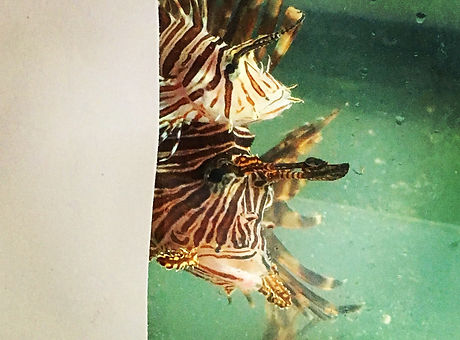Research Projects
Habitat restoration effects on juvenile salmonid predation
2019-Present
Many of the ways humans have altered rivers to make life easier for ourselves have made life harder for their inhabitants, including juvenile salmon who rear in rivers before they journey out to the ocean. This includes making river habitat less friendly for baby salmon and more friendly to their predators. Many efforts to rehabilitate or restore stream habitat for Pacific salmon include goals for reducing salmon predation by providing shallow off channel areas for salmon to hide and reducing the depth of main channel habitat where invasive predator lurk. As an ecologist with Cramer fish sciences, I develop new monitoring techniques to test if we achieve these goals on our projects and other ways species interactions influence restoration success.

Aquatic invasive species removal from island streams
2018-2019
Island streams have disproportionately high numbers of invasive species which wreak havoc on unique and delicate native ecosystems. However, common methods of invasive species management can be less effective in complex island streams and dangerous for threatened native species found nowhere else in the world. As part of a collaborative team of researchers, I helped assess the efficacy of techniques adapted for these specific environments to conduct large scale invasive species removals from Hawaiian streams. The results show that, with careful efforts to protect native species, these methods have the potential to help rehabilitate island stream ecosystems.

Ecological mechanisms of invasion success
2017-2018
Invasive species are one of the greatest threats to global biodiversity. Researchers hypothesize a greater capacity for social learning, in which individuals learn by observing other members of their population, may be one such mechanism. The red lionfish, a remarkably successful invasive, provides an opportunity to investigate this hypothesis, as lionfish appear to possess abundant mechanisms, including an apparently large capacity for learning, which facilitated their invasion success. As a Fulbright Scholar, I investigated whether and how lionfish can observe and learn from other lionfish experiencing beneficial or stressful events in novel habitat structure. Analysis of this data is ongoing, so stay tuned for updates.

Nonconsumptive predator effects
2012-2017
Through fear, predators induce prey to change their behavior, morphology, or life history in order to reduce their chances of being eaten. These defenses mimic prey consumption and can cascade to affect entire communities. For example, oyster reefs are a valuable and incredibly endangered source of habitat. Oysters make heavier, stronger shells in response to crab predators. These stronger shells may negatively impact oyster reproduction and future oyster populations. For my dissertation, I studied a complex array of factors which change the intensity of oyster predation defenses as well as defense costs. This information is important to understand how ecosystems function and to inform ongoing efforts for oyster conservation.

Predator diet cues
2013-2017
Most prey species produce plastic defenses to predators which reduce their predation risk. Prey rely on information in risk cues, often chemicals released by predators, to match costly defensive responses to their current predation risk. Many prey species detect information about a predators' recent diet and respond more strongly to predators consuming similar prey organisms. But many other species do not. I reviewed the literature on predator diet cues and described factors which may explain patterns in diet cue use across systems. I also investigated several of these factors, using oyster reefs as a model system.

Effects of black mangrove habitat expansion
2012-2017
Not everything is bigger in Texas. Although black mangroves in Texas are dwarfed by their relatives throughout the Gulf and Caribbean, they could have big impacts on local ecosystems. Climate change is causing many species, including mangroves, to expand their habitat ranges poleward. Over the last few decades, as winter freezes have become uncommon in the coastal bend, mangroves have established a thriving presence in areas historically home to salt marsh habitat. I assisted Dr. Lee Smee and his graduate student Meredith Diskin on research to understand the effects of mangroves on salt marsh communities. Mangroves change the way certain valuable species, like shrimp and fish, use coastal habitat, even where salt marsh is still abundant.

Effects of turbidity on marine communities
2010-2017
Abiotic factors, such as temperature and salinity, exert strong effects on biotic communities. Turbidity, or water clarity, reduces light penetration and we understand its obvious consequences for photosynthetic organisms. But the nonlethal effects of turbidity on other species and on community composition are largely unknown. I assisted Dr. Jessica Lunt on her dissertation research, which investigated the influence of turbidity on species communications. Turbidity reduces the success of visual fish predators but not of chemosensory crab predators. As a result, communities in turbid habitats contain lower numbers of fish and higher numbers of crabs. This influences the ability of basal oyster prey to use turbid habitats as a refuge from predation.

Reproductive habitat of the blackside dace
2011-2012
Restoration efforts must address reproductive requirements of threatened species or risk becoming a sink for resources and organisms. Habitat restoration efforts were ongoing for the federally-threatened blackside dace Chrosomus cumberlandensis, a fish endemic to the Cumberland River System, when I was introduced to this species. However, protective measures had prevented characterization of dace nesting habitat. I developed a method of visual habitat characterization to overcome this obstacle and, combined with in-stream measurements and video behavior measurements, provided the first data on this essential habitat.




